|
Topic: |
Alternative, Legacy
or Manual Focus lenses, an overview
|
|
Author/Copyright:
|
John Jovic
|
This article
explains the use of non-OEM, ie
'Alternative' (or 'Alt'), 'Legacy', 'Vintage' or 'Manual Focus' lenses, on modern
digital cameras using adapters. It is aimed at the photographer who is
not very familiar with the concept so the article explains the
basics that will then arm the photographer with enough information to
further research his or her own specific needs. This article does not
intend to detail all the different lens and camera combinations and
their compatibility, or non-compatibility.
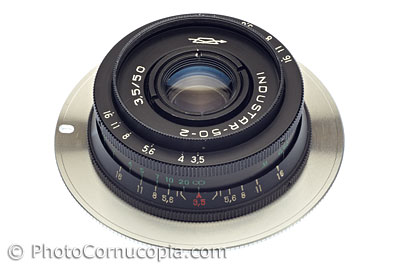 |
|
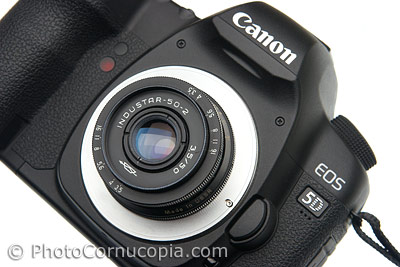 |
|
This is just one example of an 'Alternative' lens,
an Industar 50-2 lens from approx 1975 which was originally used on
the Zenit SLR. Many such lenses can be adapted for use on modern
digital cameras. It's shown here fitted to an adapter which allows it to be
fitted to another camera. |
|
Such lenses can be
adapted for use on many modern DSLR's. |
What are Alternative, Legacy or Manual Focus lenses?
Alternative, Legacy, Vintage or Manual Focus lenses are terms used to
describe quite normal lenses, such as Nikon, Olympus, Contax, Minolta,
Hasselblad, Pentax and many many others but which are being used on a
camera other than that for which the lens was intended. For example,
it's quite common to find people using Leica R, Olympus OM Zuiko or
Contax Zeiss lenses on Canon, Nikon, Pentax, Sony or other modern
digital cameras. Some times these lenses are quite old but this is not
always relevant as many modern lenses for Leica R or Contax cameras
might only be 5-10 years old but they are simply not designed to work on
anything other than their own brand of camera. Modern lenses such as
these can some times be the best of their type (or focal length) so the
reason to use them on a different camera is simply to gain the highest
possible image quality which might be lacking from the camera
manufacturers own line up of lenses.
Why go to the trouble?
Because you can...
Some times the best reason to use 'Alt' lenses is because you might
already have them, possibly having been handed down by a family member.
If you already have lenses and cameras which can be readily adapted then
why not give it a go considering the relatively low cost of some
adapters?
Some times there are very good optical, technical or practical reasons
to use Alternative lenses. Some Alt lenses might be the best of their
type so they might be the sharpest, have the least distortion, possibly
be the lightest or the fastest but other times it's simply for fun or to
achieve a look which might be unique to a particular lens. There is no
question that modern OEM zooms and primes are the best tool for the job
in many circumstances and that using manual focus lenses, which are not
even coupled to the camera, will simply be too slow and awkward.
Certain lenses have a unique look or character which can be useful in
the right circumstances. Although many people place great emphasis on
smooth Bokeh which can certainly be found in some older lenses, many old
lenses can also have Bokeh which can some times be harsh or 'swirly' and
this alone can make them a better choice for some subjects or simply for
creative effect. It's often
the lenses faults that make them the most interesting to use, quite
contrary to the near perfect optics offered in the pro zooms from Nikon,
Canon and others.
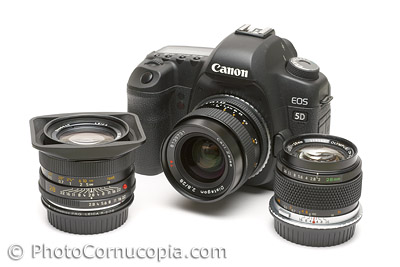 |
|
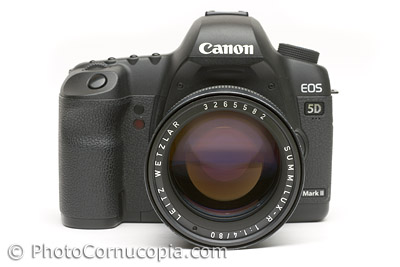 |
|
Leica Elmarit-R 28/2.8 (E55), Contax 28/2.8 MM and
Zuiko 28/2.0 are fitted with adapters and ready to go back to work. |
|
Leica Summilux-R
80/1.4 on a 5D2. |
Price is some times a good reason to use Alt lenses, but not always.
Some alternative lenses can be very cheap compared to the equivalent OEM
lenses but with very high levels of performance. However, some
alternative lenses can also be the most expensive of their kind,
possibly due to scarcity, quality or both.
How do you attach a lens to a camera it wasn't meant to work on?
The specific method used to attach lens 'A' to camera 'B' will of course
depend on the specific camera and lens in question. In general, a
specially made ring, plate or tube called an 'adapter' is used between
the camera and lens and this adapter will have been made for this
specific camera body and lens mount combination. For example, if you
want to fit an Olympus OM Zuiko lens on a Canon EF DSLR then you will
need an 'Olympus to Canon EF adapter'. One side of the adapter is
manufactured to be able to attach to the Olympus lens whilst the other
side of the adapter is manufactured to attach to the Canon body. The
thickness of the adapter is also critical because if it is too thin then
the lens will focus considerably past infinity and not operate as it was
designed (it won't be the correct distance from the film/sensor plane
which might affect optical performance with some lenses). If the adapter
is too thick then the lens might not be able to focus at infinity at all
rendering it potentially useless for anything other than close focus
photography.
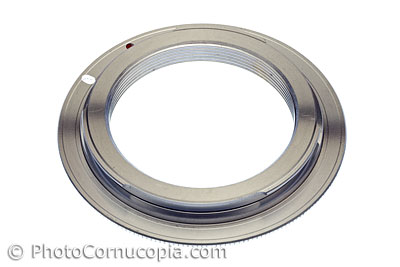 |
|
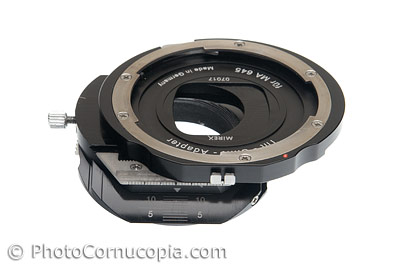 |
|
The adapter seen here is an M42 (x1.0) to Canon EF
adapter. It allows an M42 mount lens to be used on a Canon body.
This is one of the most commonly used, simplest and least expensive
adapters. |
|
This Mirex Tilt/Shift adapter is an example of a
very complex and expensive adapter. This adapter allows various
medium format lenses to be used on DSLR's with both Tilt and Shift
functionality. |
Other camera and lens combinations need to use the specific adapter for
that combination. But, not all cameras and lenses can be used
interchangeably so it's important to understand the circumstances which
enable certain combinations to be used.
Stop Down Metering, the biggest disadvantages of using adapted lenses
In almost all cases the lens will not be able to communicate with the
camera so the lens will simply be physically attached to the camera and
that's all. If you rotate the aperture ring on the lens then the
aperture will actually open or close but the exact position of the
aperture will not be known to the camera and can not be recorded in the
EXIF.
One of the consequences of this lack of connection between the camera
and lens is that exposure metering will need to take place at the
working aperture and this is
called 'stop down metering'. For example, if you want to shoot at F8 you will have to have the lenses aperture set to F8
when you take the picture but this will could make the image too dark to
focus and compose or the depth of field may simply be too wide to focus
accurately. Ideally the lens would be opened up fully to provide a
bright image and make focusing easier and then stopped down to F8 just
before the picture is taken. OEM lenses do this automatically but
adapted lenses (with a few exceptions) do not have the mechanical or
electronic linkages to the camera to allow this to happen. Adapted lenses are easiest to use when they are used wide
open, or close to it, where they can be left at the working aperture to
meter and shoot. Stop down metering is fine for subjects where there is
the time to work slowly and carefully, such as landscapes, still life,
macro etc.
Many cameras can be left in an
'aperture priority' metering mode where they will set the shutter speed
based on the light passing through the lens but some cameras might need
an exposure compensation factor dialed in depending on the lens and
aperture being used (trial and error will quickly tell you if it's
needed).
How do you focus Alt lenses?
Some adapters have electronic chips, often called 'chipped adapters',
which communicate with the camera and these allow the cameras auto focus
to indicate when manual focus is accurately achieved with the lens. This
does NOT mean that the manual lens becomes an auto focus lens, only the
cameras AF indicator in the viewfinder will light to indicate focus.
Using the auto focus assist on a cameras body won't always give you a
better focused image as the cameras AF may not be very accurate in the
first place or you might be limited to using the cameras AF points to
focus but if you are uncomfortable with focusing manually then these
chipped adapters can be quite useful. Some of these adapters can also be
programmed for the focal length to be included in the EXIF. Certain
cameras may even require a chipped adapter to allow the camera to
operate at all.
Many types of adapters are available however simple non-chipped adapters
are the least expensive and simplest to use as long as you are
comfortable focusing manually.
Focusing manually will always be the most accurate way to focus but it
is not always easy and may even take a lot of practice to become
proficient. Unfortunately most modern cameras are intended to be used as
Auto Focus cameras so their focusing screens are not always well suited
for anything else. Many cameras have focusing screens which give a
bright image which is easy to see and compose but this actually makes
the screen poor for focusing. Many cameras also have very small prisms
and viewfinder magnification so the image you see is often smaller and
darker than it could be. Some cameras allow the focusing screen to be
replaced and this is often worth doing if you plan to use Alt lenses
regularly.
The importance of accurate focusing can not be emphasised enough. You might find
that your existing lenses perform better than you think, if only you
focused them accurately and used a tripod, mirror lockup etc. All lenses
will only deliver a sharp image at the exact point where they are
focused and sharpness will fall off slowly in front and behind that
point.
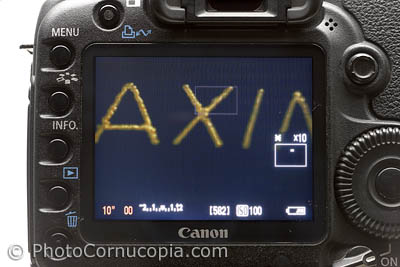 |
|
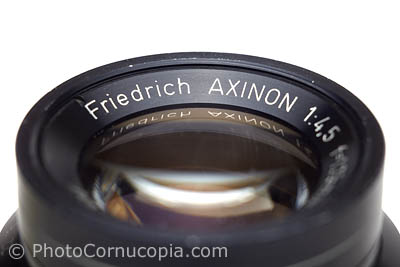 |
|
Although not practical for fast moving subjects,
using Live View (or equivalent) and zooming into the subject allows
the maximum focusing accuracy, even in dark environments where
focusing would be almost impossible. |
|
Accurate focusing is
critical to getting the most from a lens, especially where narrow
depth of field is employed. |
The best and most accurate method to focus any lens, alternative or
otherwise, is to use Live View (or equivalent) as this will allow you to
zoom in on the subject and focus exactly where you want to.
Unfortunately this method is not very practical and is also slow to use,
but so are Alt lenses, so this makes Live View and Alt lenses a match
made in heaven!
Proprietary lens mounts and register
Almost all 35mm or medium format cameras with interchangeable lenses
use a custom or proprietary lens mount. This means that the connection
between the camera and lens is unique to that specific brand of camera and that lenses
from another brand of camera can not be attached to it. These
custom lens mounts are often of the same basic design, often with a 3 or
4 prong bayonet for example, but the linkages and electrical contacts
that the lens needs, as well as various important physical dimensions, are
all quite different. So a Nikon lens will not work on a Canon body, a Pentax
lens will not work on a Minolta body etc, etc. There certainly are some exceptions, such as Yashica ML and Contax Zeiss (SLR) lenses which are interchangeable on
Yashica and Contax SLR cameras. There are also a large range of 'M42'
mount lenses which are interchangeable over a number of cameras. There
are other mounts which are interchangeable but these are less common and
usually belong to even older cameras, such as Contax, Nikon and Leica
rangefinder cameras.
The 'register' of the lens mount is one of the determining factors
regarding which cameras and lenses can be used together but there are
other factors relating to specific lenses, such as protruding rear
elements that simply won't fit inside certain cameras, or even camera
bodies which might have larger mirrors and there fore less clearance for
certain lenses to actually fit. Some times things just don't physically
fit!
The 'register' is the distance from the surface of the lens mount on the
camera to the film or sensor focal plane itself and is the same set
distance for any specific camera system or mount, such as Canon EF or
Nikon F. The register is very
important in determining if a lens can be readily adapted to another
camera because this will determine if there is enough room for an
adapter to fit between the camera and lens and still keep the lens the
correct distance from the film/sensor plane. If there is no room for an
adapter then any adapter that is used will act like a macro tube and
prevent infinity focus. Certain lens/camera combinations are effectively
ruled out because of differences in lens register, such as Minolta
lenses and Canon bodies. Using a Minolta lens on a Canon body requires
the Minolta lens mount to be drastically altered (shortened) to resolve
the difference in register. This operation (commonly referred to as
'surgery') is not for the feint hearted and is often irreversible.
Some cameras have longer registers, such as Nikon F mount, whilst some
have shorter registers, such as the Canon EF mount. This predisposes
some camera systems to being used with alternative lenses because there
is simply more room for the adapter and clearance to the rear of the
lens being used. Mirrorless cameras have a very short register
so are ideal for use with alt lenses.
Another factor is the potential for mirror 'collisions' between the rear
element of a lens and the mirror in a DSLR. Note that a crop camera like
a Canon 10-70D will have a smaller mirror than a full frame camera like
a 5D, 5D2, 6D, 1ds2/3. This is an important distinction so a lens might work
on a certain Canon crop camera, for example, but foul the mirror on a
full frame camera of the same brand, or even a full frame camera of the
same brand but a different model (5D vs 5D2). It's important to research
each specific lens and camera body combination before trying to use them
otherwise damage may result to either the camera, lens or both. Cameras
with electronic view finders such as mirrorless and M4/3 do not have this issue,
because they don't have a mirror, and are the easiest to adapt to
alternative lenses.
Other Alternative lenses
Almost any lens can be mounted to a digital camera. Some commonly used
lenses are enlarging, large format, cine, TV, video and projection
lenses. All of them have certain specific applications where they
perform best and others where they may perform poorly but can be fun to
use and can some times offer interesting creative effects.
Enlarging lenses are a group of lenses which are often overlooked for
use on modern digital cameras however many of them are ideally suited to
certain types of photography, some times more so than the lenses offered
by the camera manufacturer itself. They span the focal lengths from
around 28mm to in excess of 300mm with the most common focal lengths
being 50mm-75mm which are typically the least expensive too. Wide angle
to moderate lenses, 28mm-50mm, allow large image magnification when
mounted on a bellows so are well suited to macro work. Longer lenses in
the
75-135mm range are more useful for photographing products at close to
moderate distances.
Enlarging lenses are excellent for
product, close up or macro work and can often be used on a swing/shift
bellows to offer technical controls such as swing (left/right) or tilt
(up/down) and shift which is impossible with non
tilt/shift lenses.
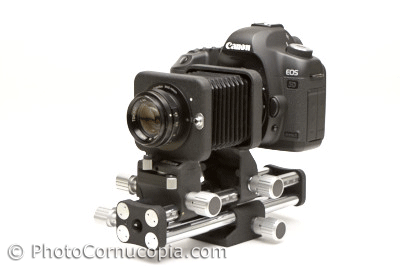 |
|
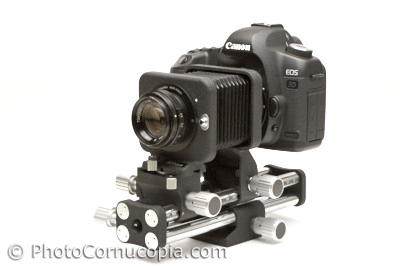 |
|
Tominon 135/4.5 lens, mounted to a Nikon PB-4
Swing/Shift Bellows, mounted to a Canon 5D2 body. This configuration
of equipment is quite useful for Macro or product photography
although it can also be used for normal scenic photography as long
as infinity focus can be achieved. The Swing action is shown above.
The term Swing refers to horizontal (left/right) pivoting
whilst Tilt refers to vertical (up/down) pivoting lens movements. |
|
The Nikon PB-4's Shift
functionality is shown above. Swing and Shift can be used
simultaneously if required, as is often the case.
The Swing and Shift functionality of the bellows
offers some, if not all, of the functionality of far more expensive
and cumbersome view or technical cameras. |
Enlarging lenses can also be used for normal photographic purposes, such
as portraits or landscapes, not just macro or product shots. However it
can be difficult to use lenses shorter than 75mm on Canon/Nikon or
similar DSLR's for normal photographic
purposes and still achieve infinity focus, although this depends on the
cameras register and the focusing mechanism (or helicoid) that is used.
The cameras register is the limiting factor so cameras with shorter
registers, such as Sony NEX and similar, allow shorter focal length
lenses to be used and still achieve infinity focus.
Although many enlarging lenses have a 'normal' or 'standard' M39x1.0
thread they also very often have unusual or unique threads such as
M39x0.75, M40x0.75, 1.5"x24tpi all of which look like an M39 thread
until you try to actually attach them! Enlarging lenses really do have a
very large range of thread sizes, especially many of the American
enlarging lenses such as Elgeet, Kodak and Wollensak, but fortunately
most enlarging lenses have very simple threads so even if a custom
adapter needed to be made it would be simple to do, but not always
cheap.
Large format format lenses can also be used and are similar to enlarging
lenses in their use and application but many large format lenses don't
quite have the very high resolution of enlarging lenses. Instead they
offer very large image circles which makes them ideal for tilt/shift
applications. Large format lenses have a relatively narrow range of
thread sizes or mounts as they are generally designed to fit into
standard shutters such as Copal 0, 1 and 3, but there are always
exceptions. This makes it easy to use them in one respect but the
problem is attaching the lens to the camera as there are no adapters
specifically designed to do this. The easiest and most common method to
adapt a large format lens to a DSLR is to use a View camera with a DSLR
adapted to the rear standard of the camera. This technique gives full
technical or view camera controls and is excellent for product shots or
close up work. The main disadvantage is that it is almost impossible to
achieve infinity focus with focal lengths shorter than approximately
80mm. Other disadvantages are weight and ease of use. View cameras are
no longer very expensive so cost is not a major factor as it might have
been many years ago.
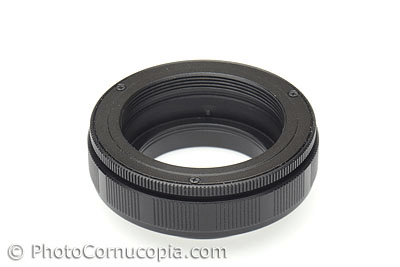 |
|
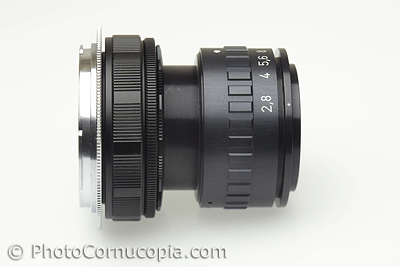 |
|
This is a Helicoid and is shown fully contracted
and extended. A Helicoid has a ring or collar which you can turn to
adjust it's length so it is a mechanism for focusing
lenses. This one has M42x1.0 threads on both front and rear so can
easily be adapted to most cameras with the appropriate adapters. |
|
This Meopta Meogon
80/2.8 Enlarging lens is being used with a Helicoid to provide
focusing ability. It attaches to a Canon Body and achieves infinity
focus. Note the various components needed to attach the lens to a
camera, from left to right, M42 to Canon adapter, M42 Helicoid, M42
to M39 adapter, then the Meogon lens itself (which has an M39
thread).
|
Many
lenses such as enlarging, large format and projection lenses do not have any focusing mechanism, or helicoid, built into them so you must provide one if you wish to focus
them. There are several ways to do this but the method you choose will
depend on the lens used. One way is to use a commercially available
helicoid where the lens attaches to the front of the helicoid and the
camera attaches to the rear. The helicoid has a ring, like a focusing
ring on a normal lens, which when rotated will alter the length of the
helicoid, thereby allowing the lens to be focused. Helicoids are
available in several lengths and the helicoid needs to be the correct
length for the specific lens used otherwise it won't be possible to
achieve infinity focus. Helicoids are most commonly available in an
M42x1.0 mount (front and rear).
Another way to focus enlarging lenses is to use a bellows with the
appropriate camera mount at the rear and possibly an M42x1.0 thread at
the front which can then have the appropriate adapter fitted for the
enlarging lens. This method is very easy to use and is generally well
suited to lenses longer than approx 80mm if infinity focus is needed.
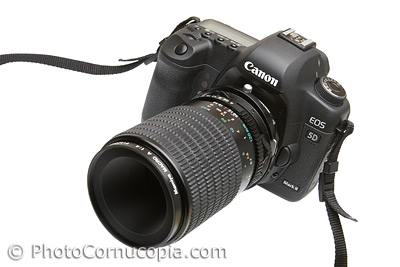 |
|
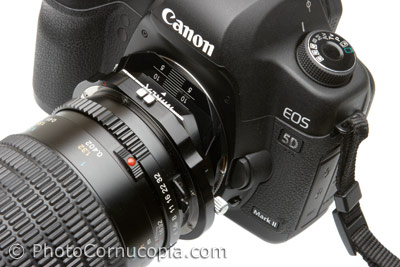 |
|
This Mamiya M645 medium format Macro lens is being
used with the Mirex adapter in place of the Canon Macro lens because
the Mirex adapter allows both Tilt and Shift adjustments which are
not possible with the standard Canon macro lens. |
|
The Mirex adapter is
shown here with 10 degrees of Tilt applied to the lens. Using Tilt
allows careful control of the focal plane which is particularly
useful when photographing products and even for general purpose
photography.
|
Many medium format lenses can also be adapted and offer certain
advantages over typical 35mm lenses because their register is so large
that special adapters with tilt and/or shift can be used to allow much
greater flexibility and technical control than normal non tilt/shift
lenses.
Where to buy adapters?
Adapters are available from various online sellers, primarily through
the popular auction sites such as Ebay, however many of the better
quality or specialised adapters are only available directly from the
manufacturers themselves.
In some cases it is not possible to buy an adapter so one might have to
be custom made. This is an expensive option but some times it's the only
way. Custom adapters might be as simple as a ring with different
internal and external threads or possibly even a complex adapter with
bayonet fittings on either side. If an adapter does not already exist
for a camera/lens then it is either technically impossible (such as
Pantax 645 to Mamiya M645) or there is simply too little demand, such as
some of the exotic enlarging lenses which have a wide range of thread
dimensions.
Some adapters can even be home made and very cheap.
"What could happen?", or, "If it sounds too good to be true..."
Although there are many advantages to using Alternative, Legacy or
Vintage lenses there are also potential problems with using lenses
that are simply, well, old. A lot can happen in 20, 30, even 50 or more
years. Some lenses are very simple and easy to repair or maintain whilst
some are very complex and require special equipment, parts and
knowledge. If you have a problem with the later type of lens then
chances are you might not be able to have it repaired at all. Most
lenses are simple enough to be repairable by experienced camera
technicians, depending on the fault of course.
There are many different things that can go wrong with a lens, depending
on the specific lens in question, so it's difficult to give a
comprehensive list of things to check. Some of the most common
faults or problems are listed below.
| Fault |
Description |
| Stiff focus ring |
The focusing ring may be too tight or stiff due
to the internal grease drying over time. The lens may have sustained
a knock or damage which may make the focusing action stiff in just
one point, but be relatively free elsewhere. Some lenses are prone
to a degree of 'play' in the focus action and this might be
unavoidable (for that model or brand of lens). |
Oily Aperture blades and/or
Sluggish Aperture blades |
Oil can creep onto the aperture blades and this
can usually be seen quite easily when looking into the lens as the
blades are stopped down. It might not cause any problems to the
operation of the lens but as the oil dries it can become sticky and
cause the aperture blades to be sluggish and possibly even
inoperative. |
| Damaged filter threads |
Most lens have a front filter thread which can
be damaged if the lens is knocked hard enough. This prevents filters
being attached to the lens. |
| Cleaning marks or Scratches in coatings or lens surfaces |
The coating on lenses can be fragile and can be
damaged by excessive or poor cleaning techniques. Damage to the
coatings may reduce contrast and increase flare. |
| Scratches or damage in lens surfaces |
Physical damage to lenses, such as scratches or
even cracks, can have a significant effect on the value of a lens if
not always on the optical performance itself. Any scratches or
damage should be avoided. |
| Lens Separation |
Some times two or more individual lens elements
are glued together to form a 'group'. When the glue is damaged,
possibly due to heat or a manufacturing fault, the lenses can start
to come apart and this is call 'Separation'. It may or may not
affect image quality depending on it's location and severity but it
will certainly diminish the value of a lens. It is expensive to
repair as the elements have to be separated and reglued by a
competent technician. Separation is often overlooked and can be hard
to spot in the first place. |
| Haze |
Haze is a coating which has formed on one or
more lens elements inside a lens. It might be caused by smoke,
particulate pollution (sucked in by the focusing or zooming action
of a lens) or condensation from grease and oils used inside a lens.
Haze has the effect of lowering contrast and reducing colour
fidelity. To clean the haze out of a lens it has to be dismantled so
this could be expensive depending on the lens. |
| Dust |
Almost all lenses have some dust inside them,
but usually small amounts. Excessive dust can cause problems, such
as flare, or even be visible in the Bokeh under certain
circumstances. |
| Fungus or Mold/Mould |
Fungus/Mould are quite common and can be very
damaging depending on the degree of the infestation. Lenses with
Fungus should be avoided as they often can not be cleaned/repaired,
depending on the degree of the infestation. |
| Inaccurate or faulty shutter |
Lenses with built in shutters, such as many
large format lenses, have leaf shutters which may or may not operate
correctly. |
| Incorrectly described |
Lenses are often incorrectly described where one
model is mistaken for another or where a line of lenses had
significant changes during the lifespan of the lens. Lenses are
often upgraded over the years by their maker so the later versions
are often more valuable or desirable than early versions (but there
are always exceptions and values can sometimes be the opposite). In
any case, it's important to know exactly what you are buying. |
| |
|
Certain
models of lenses can be prone to certain faults but it's often easy to
find these things out by doing a little research before buying the lens.
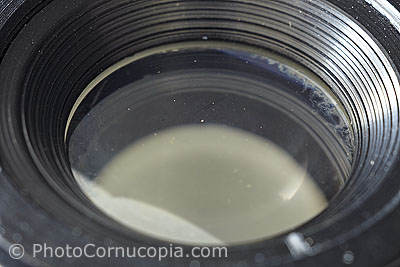 |
|
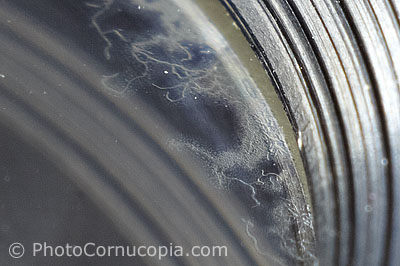 |
|
Many old lenses can be very cheap... |
|
...this is some times
the reason, fungus or mould. Many sellers do not disclose the
existence of fungus, some times because it significantly devalues a
lens, other times because they don't even know what it looks like.
|
Many
lenses are sold by inexperienced sellers who may not even recognise the
existence of faults, such as fungus, in the lenses they are selling. If buying second
hand lenses then it is advisable to do so from reliable sources and
preferably with the option to return the item if unsatisfied.
Resources
There are many online resources and forums dedicated to using
alternative lenses. Some are listed below and the links will open in a
new window. Online forums are ideal places to ask specific questions
about camera/lens combinations as it's likely that many people have
already tried it and are usually willing to share their experiences and
knowledge.
Fred Miranda Alternative Lens Forum;
http://www.fredmiranda.com/forum/board/55
GetDPI.com, The Alternative Forum;
http://forum.getdpi.com/forum/alternative-forum/
Macro/micro photography Forum;
http://www.photomacrography.net/forum/















